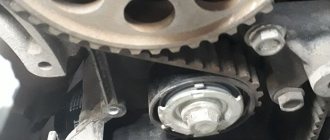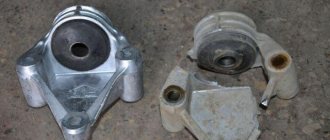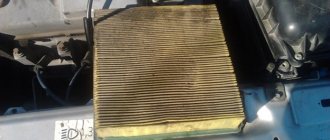The design of the gas distribution mechanism on the VAZ 2115 car is identical to the previous modifications 2114, 2112, 2110. The main purpose of the timing gear is to transmit torque from the crankshaft to the camshafts for the subsequent movement of the car.
During the systematic operation of a technical device, the drive often fails. At high speeds and rpm, the belt breaks into pieces, blocking the operation of the cylinder head and valve mechanism. There are frequent cases of holes in the block and valve bends.
ATTENTION! A completely simple way to reduce fuel consumption has been found! Don't believe me? An auto mechanic with 15 years of experience also didn’t believe it until he tried it. And now he saves 35,000 rubles a year on gasoline! Read more"
The process of replacing the drive yourself is not at all complicated, but it requires attentiveness on the part of the technician. Violation of technology is not acceptable. If you encounter any difficulties with repairs, contact a service station specialist for help.
On VAZ 2115 cars a toothed belt is pre-installed. Unlike wedge and poly-wedge, it has a long service life. The cost of the belt is 10% higher than analogues.
Early models of VAZs were equipped with chain drives, but they are not as efficient and have a higher noise level during operation.
Causes of timing belt failure
There are several reasons for this breakdown on the VAZ-2115:
- natural wear and tear;
- pollution;
- ingress of oil and foreign objects;
- pump failure;
- changing the position of the tension roller;
- camshaft or crankshaft jamming.
The role of the timing belt installed on the injector of a VAZ-2115 car is to ensure that the engine valves open at the right time. It synchronizes the camshaft pulley with the crankshaft. Therefore, it is important to change it in time when it wears out so that problems with the engine do not arise.
Articles
- 2108-1006120 – video. Attention: parts 2108-1006120 and 2112-1006120 are not interchangeable!
- 2108-1006129 – pin for the roller;
- 2108-1006040-10 - belt;
- 2108-1006149 – seal under the casing;
- 2108-1006146 – plastic casing.
Analogs of belts
- GATES 5521 or 5521XS (heavy duty), recommended
- FINWHALE BD-111
- BOSCH 1 987 949 559
- LEMFORDER 58-111-19 or 14458 01
- CONTITECH ST-527
- GOOD YEAR G1474 (semicircular tooth) or G1485 (trapezoid tooth)
- DAYCO 111x190/1
Show all articles
- HANSE HZ 011 008
- BRTI 21080-1006040-10
- TOYOTA 13568-19035
- RENAULT 7701462019
- OPEL 636359
- ROVER GTB1124
- AYWIPARTS AW2110560
- PROCODIS FRANCE 05CD27
- FAI 40305
- GK 791170
- MAGNETI MARELLI 340018181434
- MAPCO 43080
- HEPU 29-0165
- OPTIMAL R-1113
- SCT G124
- WILMINK WG1151273
- VEYANCE G1474
- OPTIBELT ZRK 1123 (3 pcs.)
- TRISCAN 8645 5521 (2 pcs.) or 8645 5124 (2 pcs.)
- FLENNOR 4410 (2 pcs.) or F904410 (belt + roller)
- LYNXauto 111CL19 (1 piece) or PK-1236 (belt + roller)
Analogues of the video
- GATES T42042 or T42042A (2 pcs.)
- MAPCO 23081
- FLENNOR FS99018
- LUK 531 0671 20
- OPTIMAL 0N1917
Show all articles
- BREDA LORETT TDI3009
- TORQUE 830900AE2
- ESPRA 2108-1006120/ES0108
- INA 531075010
- CORAM C747
- VPZ-23 830900AE1
Timing and frequency
According to the regulations for carrying out technical work, on the VAZ 2114 the procedure for replacing the timing belt and rollers should be carried out every 120 thousand kilometers. However, in reality this deadline usually comes earlier. Many car enthusiasts advise preparing for replacement after 90 thousand kilometers. Do not forget about regular inspection of the components of the gas distribution system. If you notice the slightest problem, the defective components should be replaced immediately. Failure to promptly replace faulty parasitic rollers will sooner or later lead to a broken timing belt. During a break, desynchronization of the valves and piston occurs, which leads to breakdowns and deformation of these components.
conclusions
As practice shows, setting the ignition on a VAZ-2114 is quite simple, but not every motorist can do it. So, it is necessary to have knowledge of the operation of the engine and its design. Therefore, if a motorist is not able to do this type of repair on his own, he must contact a car service center.
How to correctly and accurately set the timing marks of a VAZ 2114 with an eight-valve engine will be discussed in this article. In fact, the engines on the 14th Lada model are installed the same as on the eights, nines, and tens. There are minor differences. Therefore, this guide will also be useful to owners of these models. Let's look at the most important questions that a motorist asks himself.
Belt replacement
Required tools:
- socket wrench 10 or similar size ratchet head;
- open-end wrench 13;
- open-end wrench 17;
- slotted screwdriver (large);
- special tension wrench for the tensioner pulley;
- jack, wheel wrench;
- a little machine oil.
First you need to set the timing gear and engine flywheel in accordance with the existing marks.
1. Place the car on a level surface and engage any gear.
2.Use a jack to lift the front right wheel so that it can rotate.
3.Open the hood, use a 10mm wrench to unscrew the 3 bolts securing the timing belt protective cover.
4.Using a 13 key, loosen the generator belt tensioner and remove it.
5. On the camshaft gear we find a mark in the form of a rectangular protrusion on the edge. It should align with the protrusion on the belt cover mount.
6.If it doesn’t match, put the car in gear and turn the right wheel until the marks match.
7.After this, we find a rubber plug on top of the clutch housing. It is located to the right of the cylinder block. Pry it off with a screwdriver and take it out. Below it is the flywheel crown, which also has a mark that should coincide with the triangular protrusion on the left.
8.If there is no such coincidence, use a 17 wrench to loosen the fastening of the tension roller, and using a tension wrench, turn the roller counterclockwise, loosening the belt.
9. Having removed the upper part of the timing belt from the timing gear, use a 17 mm spanner to turn the crankshaft until the flywheel marks coincide.
10.Fix the flywheel in this position by inserting a screwdriver between its teeth. It’s great if you have an assistant who will additionally hold it.
11. Dismantle the front right wheel, remove the arch protection.
We recommend: Winter off-road tires - what can be installed, look at studded and non-studded models
12.Using a 17 wrench, unscrew the nut securing the generator pulley, making sure that the flywheel does not rotate.
13.Remove the generator pulley and take it out.
14.Now the timing belt can be removed from the crankshaft pulley.
15.Using a 17 wrench, completely unscrew the tension roller fastening and remove it; you can simply loosen it and the belt will come out.
16. Without disturbing the position of the marks, put a new belt on the crankshaft pulley, install the generator drive pulley in place, having first put the belt on it.
17. We put the belt on the timing gear.
18.Install a new tensioner roller, lubricating it on both sides with machine oil (if removed).
19. We tighten the belt by rotating the tension roller with a special wrench (if you don’t have one on hand, you can insert two pins or screws into the grooves and secure them with a screwdriver) counterclockwise. The tension at which one plane of the belt can be rotated 90 degrees horizontally using your fingers is considered normal. In this position, tighten the tension roller mounting bolt.
20. We carry out further installation in the reverse order; if your marks are lost, then you definitely need to set them again.
Preparation process
This procedure is quite simple, but before you put the tags on the VAZ 2114 and for complete convenience, you will need an assistant and a little preparation.
So, for everything to go quickly you need to:
- We find a flat surface that allows us to easily fix the car so that it does not roll (put a shoe under the left rear wheel).
- We tear off the fastenings on the right wheel and lift the car with a jack so that the wheel can be removed freely.
Jacking up the car
- We unscrew all the fasteners and finally dismantle the wheel.
- We completely remove the belt protection, for this you will need a 10mm wrench, with which you unscrew the 3 head bolts, at this point the preparation stage is considered completed, now you can safely get to work.
Removing the timing belt protective cover
IMPORTANT! Some believe that if you fix the position of the shafts when replacing the belt itself, then there is no need to make further adjustments; this is not entirely correct. A competent car enthusiast, along with the timing belt, also changes the tension-regulating roller along with the oil seal on the crankshaft. The first one tends to wear out quickly and leaves the possibility of breaking a completely new belt, and the second one is simply a disease of the entire VAZ family; over time it leaks and the car begins to “eat” oil.
Timing belt tension method
Hello, dear visitors of Drive! The other day I noticed that the timing belt started clicking. I immediately went into the garage and removed the top half of my sawed-off drive cover. Indeed, the belt turned out to be very loose. Inspection showed that the tension roller had moved.
The belt is clearly loose
The fact is that during the previous adjustment of the belt tension, the pin began to rotate along with the roller nut. Having read horror stories about the fragility of the stud, I decided not to touch it, and, having adjusted the tension, I was afraid to tighten the nut too much. I clearly tightened it weakly, and this is the result. It's good that the belt teeth didn't jump. I realized that it is undesirable to touch this unit again, and in order not to unnecessarily rotate the nut, and with it the stud, I need a reliable way to check and adjust the tension. The method proposed in many manuals for checking belt tension by twisting it 90 degrees with a force of 2 kgf does not provide for measuring this force. It is very difficult to evaluate it subjectively. As a result, the belt is either loose and slams, threatening to jump, or it is overtightened and howls like a shot down Messerschmitt in Soviet films.
How to determine that the belt twisting force is 2 kgf?
I remembered that I read somewhere a long time ago that you can tighten the belt with a household dynamometer using a special key. I bought a key on the market for 50 rubles, but it turned out to be impossible to work with it. I had to bend it into an “G” shape, screw the sector in place and make recesses for the dynamometer hook. The length of the arm from the key pins to the point of application of the torque force is 80 mm.
Special key for adjusting the timing belt tension. The distance from the pins to the groove for the dynamometer hook is 80 mm. As it turned out later, the key can be used without an additional sector
And then everything is simple. We put the x17 key on the driven gear nut and, lightly tapping it with your hand, select the slack in the drive belt branch. Next, we insert a special key into the holes of the roller axis, engage the key rod with a dynamometer and create a force of 2.5...3.0 kgf. Holding the special wrench by the sector, tighten the roller nut. The main thing here is not to overdo it and not tighten the nut with a torque of more than 4.2 kgcm, otherwise the stud may bend and the belt will subsequently slip.
Before adjustment, it is necessary to select the slack of the pulling belt branch
The force on the dynamometer should be 2.5…3.0 kgf
Having removed the dynamometer and holding the key by the sector, tighten the roller nut
If you don't have a torque wrench, you can use the same dynamometer to control the force. I did just that, only I had to put a pipe on the key, otherwise the dynamometer scale was missing. There are no photos of this action, because there were not enough hands to hold the key with the pipe, the dynamometer and the camera. I checked the quality of tension with the engine running: when revving, the radial runout of the pulling branch of the belt was 10...12 mm, which corresponds to the norm. Yes, I forgot: before adjusting, I turned the loosened pin with pliers and a rag wrapped around the thread by almost 2 turns and tightened it; It's holding up for now. Goodbye, peace and goodness to everyone!
Signs of a faulty timing belt and their causes
The main signs that the timing belt will soon fail are:
- cracks on the outer surface;
- stratification of the working fluid;
- lack of teeth on the inner surface of the belt;
- excessive stretching.
Reasons for this may include:
- long service life;
- contact with process fluids (oil, fuel, coolant) on the belt;
- violation of the geometry (deformation) of the teeth of the crankshaft or camshaft gears;
- liquid pump bearing failure;
- manufacturing defect.
Timing belt on a VAZ 2115 car
The belt drive on the VAZ 2115 is identical in size to the VAZ 2110 - 2114. Technical characteristics of the drive: length 1306 x number of teeth 116 x width 9.5 mm.
| Name/article | Price in rubles |
| Original | |
| VAZ-2112 / 2110 engine 16 valves, 2112-1006040-83 | From 1600 |
| VAZ 21120 (2110)-1006040-00 | From 1600 |
| VAZ 2112 (2110)-1006040 (16 valves) | From 1600 |
| GATES K015644XS | From 2000 |
| GATES K015536XS (16 valves) | From 2000 |
| GATES K055781XS, K015587, K015564 | From 2000 |
| Analogs | |
| BOSCH 2112-1006040 | From 1200 |
| INA 530055410 | From 1200 |
| CONTITECH CT996 | From 1200 |
| GATES 5539 | From 1200 |
| BOSCH 1987948286 (16 valves) | From 1300 |
| BOSCH 1987946329 | From 1300 |
| CONTITECH CT527K2 | From 1800 |
| CONTITECH CT1137K1 | From 1800 |
| LYNXauto 137FL22 (16 valves) | From 1500 |
| Hola TH1372 (16 valves) | From 1500 |
| BOSCH 198798527 (tension rollers) for VAZ 8 and 16 valves | From 450 |
We recommend: How to replace the instrument panel lamps on a Lada yourself?
*check prices with an authorized dealer at the time of purchasing parts.
Before purchasing components, check the compatibility of the part with your technical device. Check the article numbers with the data specified in the operating instructions.
When replacing parts, do not forget to place marks on the crankshaft and camshaft. Many car enthusiasts neglect the rule, as a result of which the engine does not start, operates unstably, and the ignition timing shifts.
Which manufacturer is better: domestic or foreign? Russian analogues are not inferior in quality to imported ones. Whether it’s worth overpaying for “delivery” - decide individually, but you need to listen to the opinion of experts.
Causes of timing belt wear on VAZ 2115
- Duration of vehicle operation without intermediate prevention and diagnostics;
- Installation of non-original parts, poor workmanship;
- Mismatch in length, width, number of teeth;
- Aggressive driving style, speed limits;
- High, low temperature conditions, climatic features of the region where the technical product is used.
How to determine when it's time to change the timing belt
The most prudent thing to do would be to install a new spare part on your VAZ-2115 before the belt breaks. The following signs may indicate that urgent replacement is necessary:
- hum and extraneous noise during operation of the power unit;
- mileage on one belt is over 60 thousand kilometers;
- oil getting into the timing belt.
In a situation with a belt, it is best to spend money on a new spare part and replace it several times than to pay later for a major engine overhaul. Manufacturers often assure that you can drive up to 100 thousand kilometers on one belt on a VAZ-2115; in fact, it is better to change it every 60 or a little earlier.
Check the belt tension regularly; if it sag or distributes the load unevenly, this component may soon need to be replaced. Remember that in this part of the timing belt there is no such thing as self-adjustment during operation. Uneven tension will inevitably lead to breakage. This part of the gas distribution mechanism must be replaced immediately after the first time it is tightened.
Be sure to monitor the battery and ignition system of your VAZ-2115, since starting the engine “from the pusher” has a detrimental effect on the condition of the timing belt. The fact is that with this type of launch, the shafts begin to move with a strong jerk, which stretches the belt and leads to a decrease in its service life.
Installation process
The timing belt itself is a rubber product closed with teeth inward, which synchronizes the torque between the camshaft and crankshaft. Ignoring its wear will not lead to anything good, because in the best case, your engine will stall while driving, and in the worst case, the entire wheelbase will jam, which can lead to the most unpredictable incidents on the road.
The replacement and debugging itself is carried out in two stages, in the first stage the main repair and debugging work is carried out, and the second stage carries the function of monitoring the work done.
First stage
- The assistant gets into the car and puts 5th gear in the gearbox, and at this time you remove the front belt protection.
- Insert the ratchet into the place allocated for it and begin to turn the crankshaft, you need to do this until you see that the mark located on the camshaft has not moved to remove several teeth from the control antenna of the rear cover. (this action is necessary to reduce the degree of belt tension).
- We dismantle the drive pulley on the crankshaft and return the mounting bolt to its place.
- The assistant switches the gearbox to “neutral”.
- Again, we begin to carefully turn the crankshaft until the mark on the VAZ 2114 flywheel is in the central position.
Coincidence of the mark on the flywheel with the slot in the bar
- We check that the installation mark of the rear cover matches the mark located on the camshaft pulley; if they match, then you can unscrew the roller nut, then remove the belt itself.
- We install a new belt - we start with the roller, then we put it on the pump pulley and lastly on the crankshaft pulley.
- We adjust the tension by turning the adjusting roller counterclockwise.
- Carefully turn the crankshaft again so that the marks are in their previous position (they will 100% go astray when putting on a new belt and adjusting the tension).
Mark on the crankshaft pulley
Second stage (control-final)
- Before checking the timing marks on the VAZ 2114, you need to fix the pulley on the generator and tension the belt with a roller to the maximum.
- Now we check all the matches, if nothing is wrong anywhere, then we install the protection back and clean the workplace.
Looking under the hood of your car, with knowledge of this information, you will understand that there is nothing difficult in this procedure, but its success is quite dependent on the skill of the performer. Therefore, if something doesn’t work out the first time, just repeat the operation, you may even need to do it twice. Don’t be discouraged, because after the difficult first time it will only take you a few minutes, like a seasoned professional.
We change the belt ourselves (on the 8 valve model)
Replacing the VAZ 2114 timing belt is strictly regulated in the car's operating instructions. It is recommended to change this part after 30-45 km. But you can’t rely only on recommendations; over time, without running the required kilometers, it slips off the gears, eats, bursts, and may even rupture.
For a car with a 1.5-liter 8-valve engine installed on it, a belt break will not have serious consequences: the car will simply stop and will not start. And in a 1.3 liter engine, the valves may become damaged, which will lead to breakdown of the entire engine. If an injector is installed on the VAZ2114, then when the belt slips, eats or breaks, the dashboard will display: “headlight sensor error.” Solve the question after how many km. This part should be changed after a visual inspection and a replacement should be made if it is in poor condition. Which strap is better to choose is written in the manual for the VAZ 2114.
Required Tools
To carry out the replacement yourself, you need to prepare new spare parts and tools:
- a set of keys;
- new timing belt;
- new tension roller.
New consumables for installation
Stages of work
The DIY replacement sequence consists of the following steps:
- The car must be set to the handbrake.
- Set to 4th or 5th gear.
- After unscrewing the three bolts, remove the cover that protects the camshaft drive.
- Next, you need to loosen the generator drive belt and remove it from the crankshaft along with the pulley, leaving the bolt that holds it in place.
- Now the car should be put into neutral gear.
- The next step is to take care of the marks. To do this, rotate the crankshaft in a clockwise direction, observing the marks and the flywheel. The shaft should be rotated until the mark is parallel to the middle division of the scale.
- After making sure that the mark on the pulley is opposite the mark on the protective cover, you need to slightly loosen the fastening nut on the tension roller. If necessary, change the tension roller.
- Using a roller, you need to loosen the tension of the strap to remove it.
- Next, you need to install a new product on the crankshaft timing pulley.
- Then you need to pull the leading branch of the product onto the camshaft pulley so that it does not sag.
- Then turn the crankshaft 1.5-2 turns and set the marks. If the marks do not match, the belt should be removed and the installation procedure repeated again.
- After setting the marks, you need to unscrew the bolt on the crankshaft and put the generator pulley in place, securing it with the bolt.
- By turning the tension roller counterclockwise, it is necessary to adjust the timing belt tension and put on the alternator belt.
Nut for loosening and tightening
- After completing all the work, you need to start the engine and determine by the sound whether it is necessary to adjust the belt tension.
Why you should change the timing belt yourself: you will save time and money, you will know what to do if it slips or eats.
Checking the set ignition
To check the ignition on an 8-valve engine, an injector, you should prepare:
- Multimeter.
- Set of keys and screwdrivers.
- Pliers (necessarily with insulated handles).
Attention! Due to the lack of special equipment, the described method can only test the operation of the circuits. Diagnostics of the microprocessor part will not be available.
The process is:
- When the ignition is turned off, check how tightly the high voltage wires are seated and what contact is in the module.
- Remove the connector from the module, connect a multimeter (monitoring mode should be low AC) to pins C and B, make sure there is voltage. Check the coil (2nd and 4th contacts).
Checking the presence of power on the ignition module
- Check the functionality of high-voltage wires. Install a working spark plug in each cap in turn, attach one end to the block and crank the engine with the starter. The presence of a spark signals that everything is normal. Its absence on each wire means the module is faulty.
Checking high voltage wires
If you managed to set the ignition correctly on the VAZ model and this was confirmed by the test, but problems are still observed, you need to check the power system.
Timing roller location
Before you begin diagnosing or replacing the timing belt and rollers on a VAZ 2115 with 8 valves, you need to determine where the system itself is located. You can find it on the left side of the engine if you stand in front of the hood. It is located under a protective cover that prevents debris and dust from entering the system. For visual diagnostics, simply unscrew a couple of bolts and remove the upper part of the casing. However, if you are planning a more serious operation, such as replacing a belt or rollers, this will not be enough.
Preparatory operations
It's immediately obvious that the owner loves his car.
VAZ engine 8 valves.
If you plan to replace the pump, then let the engine cool, remove the protection and then drain the antifreeze. It is enough to drain only from the cylinder block.
Plug on the cylinder block.
Jack up the car and remove the front right wheel and plastic mudguard.
Why change the belt?
In the list of routine maintenance for the VAZ 2114, the manufacturer provides for replacing the timing belt every 60-75 thousand kilometers. However, given the quality of our spare parts, experienced car enthusiasts recommend replacing it after no more than 30-40 thousand km.
The belt should be visually inspected for visible mechanical damage at least once a month. If the slightest problem is detected, it must be replaced immediately.
If this is not done, the tension pulley may fail, as well as the water pump. In addition, there are cases when parts of the belt wrap around the generator pulley, which leads to blocking of its shaft.
But there is also good news. In VAZ 2114 cars with 8-valve engines of 1.5 and 1.6 liters, a broken belt does not threaten bending of the valves and damage to the cylinder head, which cannot be said about sixteen-valve engines, where a similar problem occurs in 90% of cases.
In conclusion
Correct operation of the timing system is the key to reliable and proper operation of the engine. Therefore, you should be very careful both in caring for this system and the belt, and in protecting it. Many domestic car enthusiasts like to drive without a protective cover, which should not be done under any circumstances if you do not want to reduce the replacement cycle by half.
Published February 04, 2018
Next we will talk about two engines - 2111 and 11183. The VAZ plant installed them on Lada-114 hatchbacks. The cylinder head assembly in these engines contains not 16 valves, but 8, and any novice mechanic can replace the timing belt on a VAZ-2114: the valves do not touch the pistons in any position of the pulleys. There is only one timing pulley here, and it must be aligned to the mark in the same way as the crankshaft. Let's look at the details.
What we are going to do takes professionals 10 minutes. Let's look at an example of replacing a VAZ-2114 timing belt in the video:
Removing the old timing belt
Work order
1. Place the machine on a horizontally level area and secure it with the parking brake.
2.In the engine compartment, it is necessary to remove the protective plastic timing cover. To do this, unscrew the 3 bolts securing it (10 wrench).
3.Using a wheel wrench, slightly unscrew the bolts securing the front right wheel disk.
4.Raise the car body near the right front wheel with a jack. Completely unscrew the bolts securing the disc and remove the wheel.
5. Unscrew the two bolts securing the protective casing (engine protection) in the area of the right front wheel.
6.Unfold the protective cover.
7. We loosen the tension of the generator belt by unscrewing the tensioner nuts (wrenches 10 and 13).
8.Move the generator towards the crankshaft pulley.
9. Dismantle the alternator belt.
10.Now you need to remove the crankshaft pulley. It is secured with a 19mm bolt. Very often, unscrewing it is quite problematic, since the pulley itself must be fixed. In carburetor engines it has holes located around the circumference. Here it is easier to insert a screwdriver or key into one of the holes and thus immobilize it. There are no such holes in injection engines, so you can fix the crankshaft either by immobilizing the flywheel, inserting a screwdriver between its teeth and the clutch housing, or by resting the key (curved end) on the right tie rod, as shown in the photo, and crank the crankshaft using the starter .
11.Unscrew the bolt, remove the generator drive pulley, screw the bolt back in.
12.Remove the timing belt.
13. Loosen the tensioner roller nut (key 13).
14. We dismantle the tensioner pulley and install a new one in its place without tightening the nut that secures it.
15.Now you need to align the camshaft and crankshaft to the marks. To do this, take a 17mm wrench, place it on the camshaft gear fixing bolt and rotate it until the mark on it coincides with the protrusion on the inner protective (metal) belt cover. Next, using the same key, placed over the crankshaft pulley mounting bolt, we rotate the crankshaft until the marks on the timing gear (drilled funnel) and on the engine housing (cast protrusion) match.
16. Additionally, it would not hurt to make sure that the position of the flywheel is consistent. The mark on it should coincide with the notch on the clutch housing.
17.If everything is in order, proceed to installation.
Setting the tags: step-by-step instructions
Tools for working with timing marks
In order to correctly set the timing marks, you will need the necessary tools. So, what is directly required in order to perform this operation:
- Key for 10.
- Thin flathead screwdriver.
- Jack.
The process itself
Now that everything is assembled, you can proceed directly to the work process itself:
- Jack up the right side of the car.
Setting up the car on a jack - Under the hood, unscrew the timing belt protective cover. We unscrew the mounting bolts of the timing case. Dismantling the lower fastening of the timing case. We remove the unscrewed casing from the engine.
- Rotate the right front wheel until the camshaft mark matches the pulley and the block.
We set marks on the camshaft and block - Remove the plug on the gearbox housing.
We look, if the marks on the flywheel and the housing coincide, then everything is fine, if not, we rotate the wheel until the mark on the camshaft and flywheel coincides with the marks on the block. Remove the crankcase plug, where the mark on the flywheel should coincide with the block - If the marks do not match even when turning the crankshaft 4-6 times, then you will have to remove the timing belt . Read more about removal and subsequent installation with the correct tension here. The camshaft mark matches, and only at this moment do we remove the strap. Next, rotate the crankshaft until the marks match on the flywheel. After performing these operations, you should put on the belt.
- Thus, the timing marks are set, and you can begin to perform other operations.
Consequences of incorrectly setting timing marks
The consequences of incorrect placement of the timing marks on the car can be both minor and very severe.
A torn timing belt on an 8-valve valve does not threaten to bend the valves, but the 16-valve version of the VAZ-2114 is already deprived of this advantage.
Let's consider the main options for the development of events:
- Misaligned timing will cause the valves to burn out .
- Bent valves (bent valves) are also an unpleasant option. The 8-valve version of the VAZ-2114 does not bend the valve.
- As a result of the above actions, the cylinder head may become deformed , guide bushings may fail, and cracks may form inside the main power elements.
- Burnout of the piston mechanism also becomes a consequence of incorrect placement of the gas distribution mechanism marks.
- Oil residue on the spark plugs , as well as poor ignition timing of the fuel mixture.
- Other consequences.











